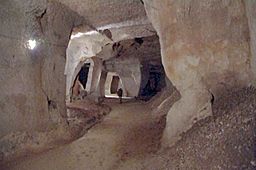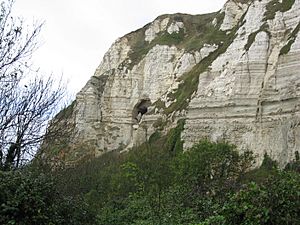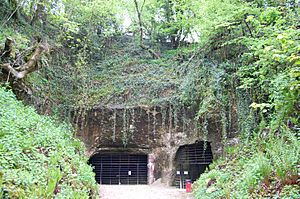Beer Quarry Caves facts for kids
Quick facts for kids Beer Quarry 'Caves' |
|
|---|---|

The interior of Beer Stone Quarry
|
|
| Location | Beer, Devon, UK |
| Geology | Limestone |
| Difficulty | Easy |
| Access | Public tourist attraction |
The Beer Quarry Caves are a huge underground network of tunnels in Devon, England. They are not natural caves but were dug by people over 2,000 years! These tunnels were created by quarrying (digging out) a special kind of rock called Beer stone. This stone was very popular for building important places like cathedrals and churches. People liked it because of its nice colour and how easy it was to carve.
Stone from these quarries was used to build many famous buildings in southern England and even some in the United States. Most of the digging happened during the Middle Ages, but it continued until the 1920s. Today, the quarry is part of the Jurassic Coast, a famous coastline, and is also a special protected area called a Site of Special Scientific Interest (SSSI).
Contents
What is Beer Stone?
Beer stone is a type of limestone that is creamy-grey and has a very fine texture. It comes from the Middle Cretaceous period, which was a very long time ago! It gets its name from the town of Beer, where it has been dug out since Roman times.
The best layer of Beer stone is about 30 feet thick and doesn't have many flints (hard rocks). This stone is called a "Free stone" because it can be cut or shaped in any direction. This is because its tiny crystals don't stop you from working it in different ways. When it's first dug out, it's quite soft and easy to cut. But once it's exposed to the air, it gets much harder, almost as hard as Portland stone.
How Was Beer Stone Mined?
People have been digging for Beer stone for a very long time, starting with the Romans.
Roman Digging Methods

The first digging was done in open pits. But soon, people had to dig into the side of the hill because of other layers of rock above the stone. During the Roman period, the nearby River Axe estuary (where the river meets the sea) was a safe place for boats to pick up the stone.
The Roman parts of the quarry have big arches that hold up the roof. Workers dug these out by hand using picks and wooden wedges. Beer stone was even used in a Roman villa (a large house) in Seaton.
Norman Digging Methods
The Norman workings connect directly to the older Roman quarry. They dug even deeper into the hillside. These parts of the quarry have large rectangular columns that support the roof. You can also see several smaller tunnels branching off.
Medieval Quarry Life
Quarry workers in the Middle Ages spent long hours digging by candlelight. They used hand tools like picks and saws. Sometimes, children also helped with the work. Skilled stonemasons would often carve the stone right there in the caves. This was because the stone became harder to carve once it was exposed to the air.
After the stone blocks were cut, they were lifted by hand-operated cranes. Special lifting devices called Lewis were used to attach the blocks. Then, the heavy stone blocks were loaded onto wagons pulled by horses. Usually, they were taken to Beer Beach and put onto barges (flat-bottomed boats) to be moved by sea. After the year 1540, Beer stone was mostly used for non-religious buildings.
Later Uses of the Caves
After the Reformation (a big change in religion in England), some parts of the caves were used as a secret place for people to practice their faith. In the 1800s, the caves were also used to hide things that had been smuggled into the country illegally. A famous smuggler named Jack Rattenbury used them for this purpose.
Digging for stone at this site stopped in the early 1900s when a new quarry opened nearby. Some of the old caves were then used to grow mushrooms. Others were used to dump waste from the new quarry.
Today, you can take guided tours of the caves from spring to autumn. In winter, the caves become a safe home for hibernating bats. The presence of these bats, along with the chance to see the different rock layers, led to the old and new quarries being named a Site of Special Scientific Interest. Very rare bats like the Bechstein's bat and the greater and lesser horseshoe bats, along with five other bat species, all live in these caves.
Famous Buildings Made with Beer Stone
Many important buildings were built using Beer stone. Here are a few examples:


